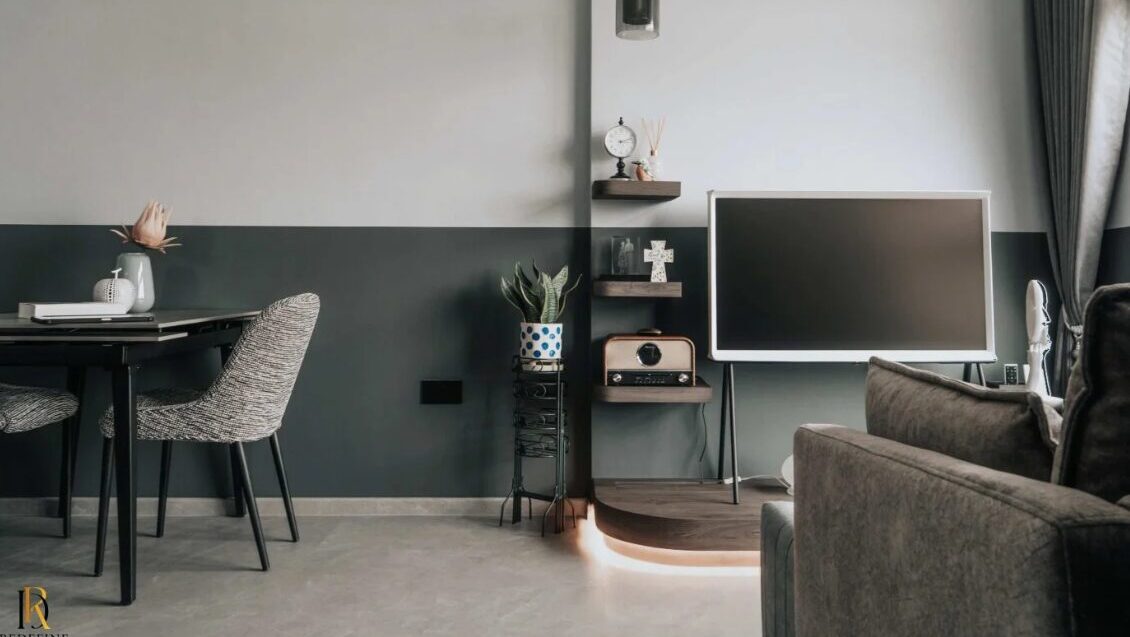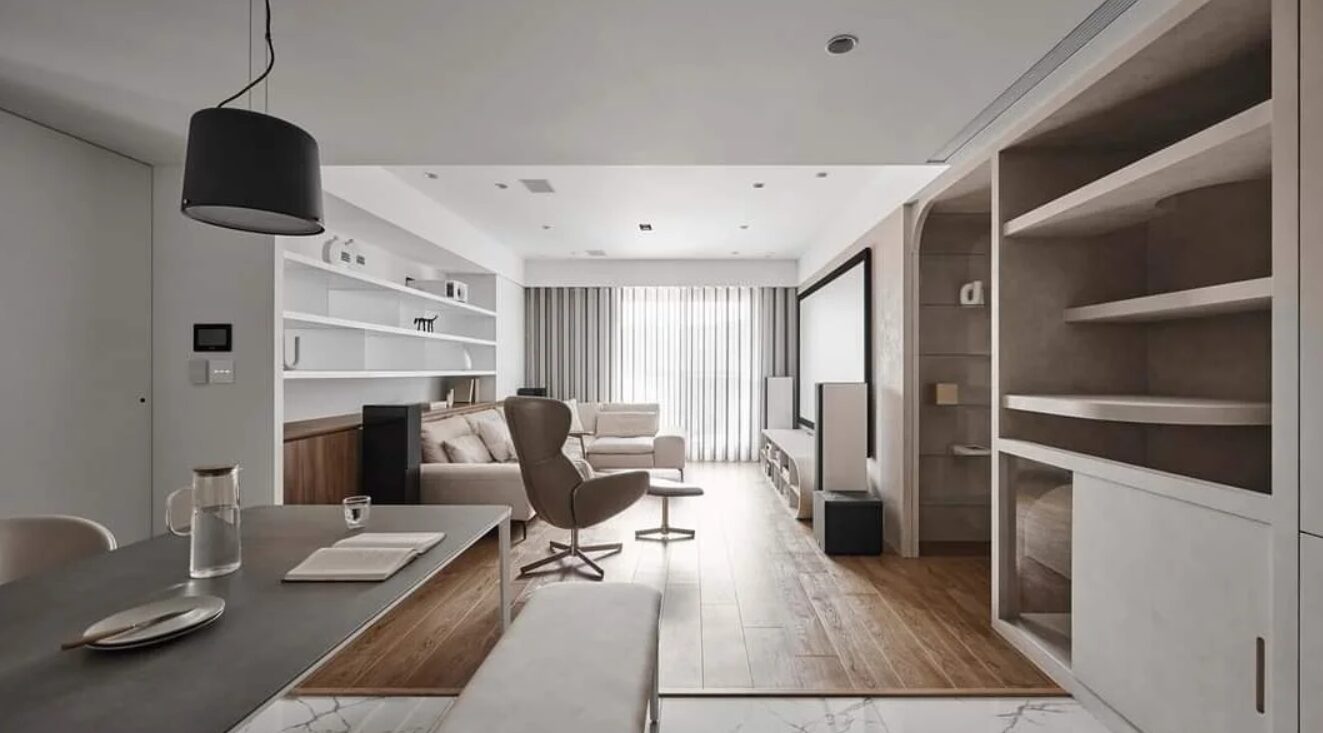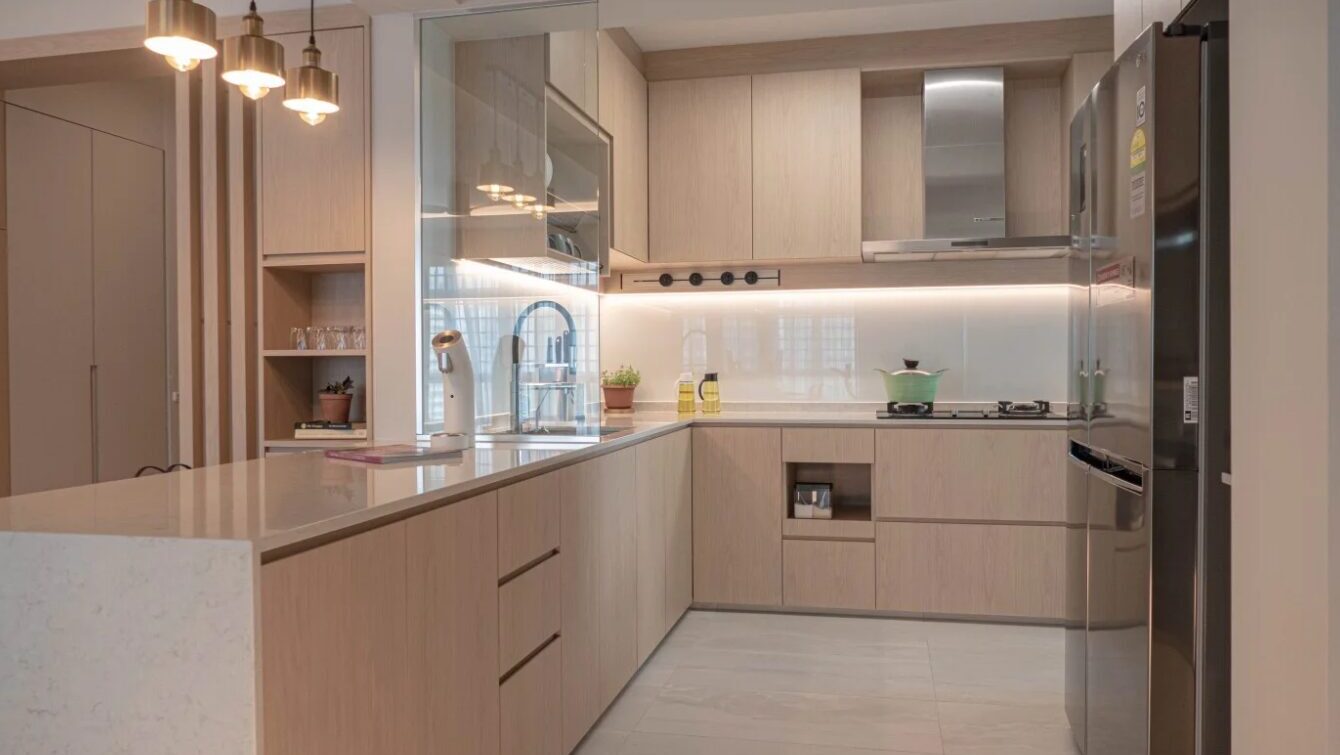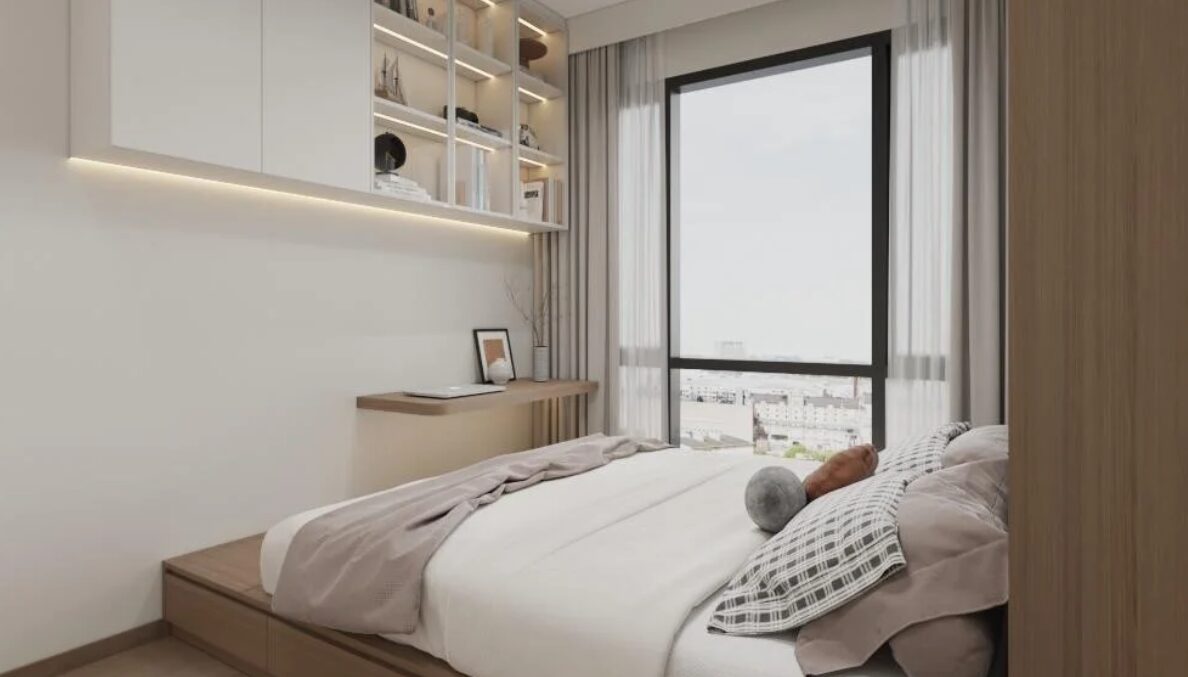Mastering Minimalism: 5 Tips for a Clean and Simple Interior
| Topic | Details |
| Core Principles of Minimalism | Simplicity, functionality, airy spaces, natural materials; emphasising ‘less is more’ to create a serene environment. |
| Effective Decluttering | Systematic approach; categorisation, functional storage, digital decluttering; maintaining an organised, clutter-free home. |
| Minimalist Kitchen Design | Combines sleek aesthetics with practicality; modern appliances, neutral colour palette, and layered lighting solutions for a functional, stylish kitchen. |
| Incorporating Colours in Minimalism | Use muted or pastel hues; 60-30-10 rule for colour distribution; textures, artwork, and plants to add subtle colour variations. |
| Popular Minimalist Styles in Singapore | Scandinavian, Japandi, Industrial, and Heritage-inspired minimalism styles; integration of eco-friendly practices. |
The minimalist interior design style has become increasingly popular due to its focus on simplicity, functionality, and tranquillity, which aligns with the fast-paced lifestyle of Singaporeans. At its core, minimalist interior design emphasises decluttering and creating open, airy spaces through a careful selection of essential elements. In this article, we are going to explore how a minimalist home can feel spacious and orderly, free from distractions and unnecessary adornments.
What are the core principles of minimalist interior design?
This design approach is guided by the principle that less is more, relying on a monochromatic colour palette, clean lines, and natural materials. These elements combine to craft a serene and calming space that enhances the beauty of items by not overwhelming the senses.
To achieve a minimalist interior, one of the key practices is to meticulously curate every piece within the space. Each item should serve a purpose or bring joy, eliminating the clutter and complexity from daily living. Moreover, multi-functional furniture plays a significant role in minimising space usage, particularly in smaller HDB flats commonly found in urban Singapore. For example, a sofa bed or a dining table that doubles as a workspace are practical choices for a minimalist home.
Textures and materials are other vital aspects of creating a minimalist home. Natural elements such as wood, stone, and metal can be incorporated to add warmth and visual interest without overwhelming the space. Just as important is the use of light—both natural and artificial—to create a sense of openness and continuity. Employing ample windows, strategically placed lighting fixtures, and reflective surfaces can allow light to flow freely, creating an inviting atmosphere.
Maximising space with the right layout is another key principle in minimalist interior design. Carefully planning the placement of furniture and décor ensures that there is a smooth flow of movement throughout the home, and each area serves its intended function without any overlap. This efficient use of space is crucial for a minimalist design, ensuring that every square metre is utilised to its fullest potential.
In addition to functionality, the aesthetic value of minimalist design cannot be understated. While the style may seem stark and plain, the elegance of minimalist design lies in its ability to highlight beauty in simplicity. By focusing on the essence of each element, minimalist interior design creates a harmonious environment where each piece stands out and complements the whole, fostering an environment that is both cohesive and holistic.
How to declutter effectively for a minimalistic home?
Decluttering is the cornerstone of achieving a minimalistic home, where the focus is on creating a space that is free of distractions and unnecessary items. The process of decluttering requires a thoughtful and systematic approach, starting with an honest assessment of each room and its contents. Begin by sorting through items and asking whether they serve a purpose or add value to your life. If the answer is no, it may be time to let go of such items to make way for a more organised living space.
The key to effective decluttering lies in categorisation. Group similar items together to gain a better understanding of how much of each category you possess, and what may potentially be redundant. This sorting process often reveals duplicate or unused items that can be discarded or donated. Furthermore, consider applying the one-in, one-out rule, where for every new item brought into the home, an old one must be removed. This practice prevents clutter from building up over time and encourages mindful consumption.
Smart storage solutions are crucial in maintaining a tidy space. For a more structured approach, tackle one room at a time to avoid feeling overwhelmed by the sheer volume of items. Break down the process into smaller tasks, such as starting with one drawer or cabinet, before moving on to larger spaces. This gradual progression helps maintain focus and fosters a sense of accomplishment with each completed step. Setting specific goals and timelines can also aid in keeping the decluttering initiative on track.
Incorporating storage solutions is an essential aspect of decluttering. Invest in functional storage that complements your minimalist aesthetic, such as sleek cabinets, concealed shelving, or under-bed storage. These solutions aid in establishing dedicated zones for each item, ensuring that clutter is kept out of sight and that every piece has a designated spot. This organised system simplifies cleaning and maintains a tidy and orderly home environment.
Another tip for decluttering is to be mindful of sentimental items. While it is important to cherish memories, it is equally vital to avoid allowing them to accumulate and create clutter. Be selective about the memorabilia you choose to display and consider digitalising keepsakes like photos and letters to preserve them without taking up physical space.
How to incorporate colours in a minimalist interior?
Incorporating colours in a minimalist interior requires a delicate balance to maintain the simplicity and tranquillity central to minimalist design. Traditionally, minimalist spaces rely on neutral colour palettes, dominated by whites, greys, and earthy tones, to achieve a serene and unobtrusive backdrop. However, subtle incorporation of colour can add depth and interest without compromising the minimalist aesthetic.
When choosing colours for a minimalist interior, opt for muted or pastel hues that add warmth and character to the space while maintaining a calming effect. Colours like soft blues, pale pinks, and gentle greens can infuse life into a room without overpowering its simplicity. Applying these colours as accents whether on a single wall, through textiles, or in decorative pieces keeps the overall design cohesive and harmonious.
Consider employing the 60-30-10 rule to guide colour distribution within a minimalist space. This rule suggests that 60% of the room should be a dominant neutral colour, 30% a secondary colour, and 10% an accent colour. This approach ensures that even when incorporating colour, the overall look remains balanced and uncluttered, with the dominant shade serving as a unifying base.
Textures also play a significant role in adding layers of colour to a minimalist interior. Natural materials like wood, stone, and leather have inherent colour variations that enrich the palette without the need for additional hues. Textiles such as rugs, throw pillows, and curtains can introduce subtle colour shifts that contribute to a cosy atmosphere in a minimalist setting.
Artwork provides an excellent opportunity to introduce colour into a minimalist space while retaining its clean design ethos. A single bold piece of art can act as a focal point, injecting energy and personality into the room. When selecting art, choose pieces that mirror or complement the existing colour scheme to maintain coherence.
Plants are another effective way to incorporate colour naturally. The various shades of green found in indoor plants can enliven a minimalist space, adding a fresh, organic touch. Plants not only introduce colour but also enhance the visual appeal by bringing elements of nature indoors, promoting a sense of tranquillity and balance.
Lighting choices can also influence the perception of colour in a minimalist interior. Soft, warm lighting creates a gentle ambience, while cool lighting can heighten the clarity and crispness of colours. Thoughtfully placed light sources highlight specific areas and colours within a room, allowing for a dynamic interplay of light and shadow.
Incorporating colour in minimalist design should be a thoughtful, intentional process that respects the principles of simplicity and balance. By selecting a restrained palette, utilising natural materials, and strategically employing colour through accessories and artwork, you can create a minimalist space rich in character and vibrancy, reflecting personal style while maintaining a serene environment.
Can a minimalist kitchen be stylish and functional?
A minimalist kitchen can indeed be both stylish and functional, combining the sleek aesthetics of minimalism with the practicality needed for cooking and dining. The hallmark of a minimalist kitchen is its clean, uncluttered design that utilises every inch of available space efficiently. By focusing on the essentials and employing smart design solutions, a minimalist kitchen not only looks elegant but is also equipped for daily use.
Incorporating modern appliances is a key aspect of creating a functional minimalist kitchen. Sleek, energy-efficient appliances integrate seamlessly into the overall design and often come with multifunctional capabilities that save space and enhance convenience. Induction cooktops, integrated ovens, and compact dishwashers are examples of technology that keep the kitchen functional without sacrificing its minimalist appeal.
Organisation is another critical component of a minimalist kitchen. The strategic use of storage options such as built-in cabinets and open shelving help maintain a clutter-free environment. Optimal arrangement of utensils, dishes, and ingredients ensures that essentials are always within reach while maintaining a tidy, open space. Drawer organisers, hidden compartments, and pull-out shelves further enhance usability, transforming the kitchen into a model of efficiency.
One common design approach in minimalist kitchens is to select a neutral colour palette. Whites, greys, and earthy tones create a calming atmosphere and give the illusion of a larger space. This effect can be heightened by using materials like light wood, stainless steel, and glass, which reflect light and create a sense of openness. A consistent palette unifies the kitchen design, making it both stylish and serene.
Key lighting solutions enhance the kitchen’s aesthetic. Countertops play a pivotal role in the aesthetic and functionality of a minimalist kitchen. Opt for durable materials such as quartz or marble, which not only provide a clean and polished look but are also easy to maintain. Keeping countertops clear of unnecessary items enhances the minimalist feel and provides ample workspace for meal preparation.
Lighting is crucial in a minimalist kitchen, as it adds dimension and accentuates design features. Natural light should be maximised where possible, and layered lighting solutions such as under-cabinet and pendant lighting can create a warm, inviting glow. Bright, well-lit spaces enhance the minimalist aesthetic, making the kitchen appear brighter and more spacious.
In minimalist kitchens, decoration is minimal but thoughtful. Select a few statement pieces, such as a backsplash, light fixtures, or a single piece of art, to add personality without detracting from the cohesive design. These elements should complement the overall aesthetic and serve as focal points that draw the eye without overwhelming the space.
Balancing style and functionality in a minimalist kitchen requires a harmonious blend of design principles and practical considerations. By prioritising essential elements, incorporating modern appliances, and employing smart storage solutions, a minimalist kitchen can be both a visual delight and a culinary powerhouse.
FAQ
How can I start incorporating minimalist design elements in my home?
Starting with minimalism can begin with decluttering your space by evaluating items based on their necessity and contribution to an organised environment. Focus on creating open areas by selecting multifunctional furniture and using light colours to create an airy atmosphere. Implement storage solutions to maintain order and gradually infuse minimalist elements into each room of your home.
What storage solutions are recommended for a minimalist home?
Functional storage solutions recommended for a minimalist home include hidden compartments, built-in cabinets, and under-bed storage to keep spaces uncluttered. Consider modular furniture that offers flexibility and can be adjusted to maximise space efficiency. Shelves that blend with the interior design can also help keep belongings organised and accessible.
Which colours work well with minimalist design without overpowering it?
Colours that work well in minimalist designs are typically neutral tones such as whites, greys, and taupes, and muted pastels that maintain a calm environment. These colours add warmth and character without overwhelming the clean aesthetic. Incorporating textures and plants can also add depth to the colour scheme while remaining subtle.
How does industrial minimalism differ from other minimalist styles?
Industrial minimalism distinguishes itself from other styles by embracing raw materials such as concrete, exposed brick, and metal elements. It fuses the minimalist focus on open, functional spaces with an edgy, rugged aesthetic, often incorporating vintage or repurposed elements to enhance the industrial feel.
What are the benefits of adopting a minimalist lifestyle in an urban setting like Singapore?
Adopting a minimalist lifestyle in an urban environment like Singapore offers benefits such as efficient use of limited space, creating a calm retreat from the bustling city life, and reducing environmental impact through sustainable living practices. It also emphasises quality and intentional living, allowing for a more meaningful and organised home environment.
Are you looking to upgrade your home? Look no further! Drop us an enquiry at media@redbrick.sg and let us help you transform your home into a smart and efficient living space. Our experts are here to assist you in finding the perfect smart home devices to suit your needs and enhance your lifestyle.
Designing your dream home can be an exciting journey, but it can also be overwhelming. With so many options and styles available, it can be challenging to decide what is best for you and your family. However, by considering factors such as functionality, color palette, furniture, materials, and personal style, you can create a space that is not only beautiful but also practical and comfortable.
When it comes to achieving a successful interior design project, choosing a provider with a rock-solid reputation and exceptional skills is paramount. At Redbrick Homes, we understand that inspiration is key. That’s why our top-quality interior design partners are ready to wow you with beautiful, personalized spaces brimming with exceptional Singaporean ideas.
Remember to take your time, do your research, and work with a professional if needed. With the right interior design choices, you can transform your house into a dream home that you’ll enjoy for years to come.










